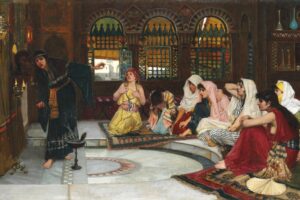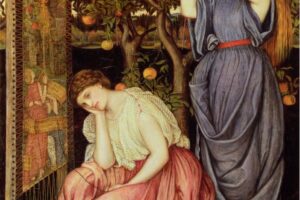Table of Contents
Overview
After the Dance (1876) by John William Waterhouse is a quiet yet poignant scene, painted when the artist was still in the early stages of his career. Known later for mythological and literary subjects, Waterhouse here explores a moment of human tenderness.
In a classical interior, a young girl lies resting after performing, her tambourine still in hand. Another girl sits beside her, offering gentle companionship. In the distance, musicians continue to play. The painting is understated but full of sensitivity, showing Waterhouse’s growing mastery of composition, light, and storytelling.
The Story Behind the Painting
An Early Work
Painted in 1876, After the Dance belongs to Waterhouse’s formative years, before he gained fame for his mythological heroines like The Lady of Shalott. At this time, he drew inspiration from the Pre-Raphaelites and from classical antiquity, blending naturalism with historical settings.
Inspiration and Themes
The subject is not drawn from myth or literature but from everyday human experience. It shows the exhaustion that follows festivity, the tender pause after performance. For Victorian audiences, it would have evoked themes of innocence, companionship, and the delicate balance between art and life.
Waterhouse’s Path
As an artist, Waterhouse was already interested in staging moments of intimacy against classical backdrops. This painting foreshadows his later ability to unite psychological depth with decorative detail.
Composition and Subjects
The Resting Dancer
In the foreground lies a young girl draped in a terracotta skirt and white blouse. Her tambourine slips from her hand, still decorated with ribbons, a sign of the performance just ended. Her body is languid, her expression peaceful, as though she has given herself fully to the dance and now surrenders to rest.
The Companion
Beside her sits another girl, upright, alert, and quietly watchful. Her pale tunic leaves her arms bare, and her hand gently rests on the dancer’s body. She embodies friendship, care, and solidarity — a presence of comfort after exertion.
The Musicians
In the background, framed by columns, two male musicians continue to play the double pipes and strings, oblivious to the girls’ rest. Their placement emphasizes contrast: the formal continuation of music against the intimacy of repose.
The Classical Interior
The setting is unmistakably classical — a mosaic floor, marble columns, patterned wall hangings. This choice anchors the scene in antiquity, aligning it with Victorian fascination for the ancient world, while also enhancing the timelessness of the subject.
Art Style and Techniques
Naturalism and Tenderness
Waterhouse paints the figures with naturalistic attention, from the soft folds of fabric to the relaxed posture of the resting girl. His treatment of skin tones is delicate, conveying warmth and life.
Early Pre-Raphaelite Influence
The sharp detail of the mosaic, the decorative fabrics, and the storytelling moment reflect Pre-Raphaelite influence. Waterhouse admired their jewel-like colors and precision, and here he applies those principles in his own emerging style.
Foreshadowing Later Mastery
Though not as elaborate as his later mythological works, After the Dance reveals Waterhouse’s gift for staging narrative moments in decorative settings. The balance of intimacy and grandeur would become his signature.
Legacy and Reflection
An Artist in Formation
Today, After the Dance is appreciated as an early glimpse of Waterhouse’s developing style. It shows how, even before he turned to Ophelia, Circe, or the Lady of Shalott, he was already concerned with beauty, emotion, and timeless themes.
Enduring Meaning
The painting resonates as a meditation on human fragility and companionship. The resting girl, her tambourine slipping away, is an image of vulnerability; the companion’s quiet presence becomes a symbol of care. The title reminds us that life’s most poignant moments often come not during performance, but in the silence after.
She lies quiet, tambourine fallen, while her companion watches over her. Beyond them, music plays on. In this contrast, Waterhouse finds the poetry of pause — a tender truth that lingers long after the dance has ended.
About Artist

John William Waterhouse RA (baptized April 6, 1849 – February 10, 1917) was a renowned English painter closely associated with the Pre-Raphaelite style and Victorian Romanticism. Born in Rome to English painter parents, Waterhouse moved to London in childhood, where he was exposed to a rich artistic environment near the Victoria and Albert Museum. He trained at the Royal Academy of Art, initially studying sculpture before switching to painting. Waterhouse became famous for his vibrant, detailed depictions of mythological, literary, and classical subjects, bringing the Pre-Raphaelite aesthetic into the early 20th century.
Artist Style and Movement
Waterhouse’s style bridges Academic art and Pre-Raphaelite influences, characterized by luminous colors, precise detail, and narrative richness. His subjects often derived from classical literature, myths, and poetry—especially works by Tennyson, Shakespeare, and Homer—delivered with romanticism and emotional intensity. He focused on female protagonists, enchantresses, and tragic heroines, exploring themes of love, fate, and destiny. Though rooted in Victorian ideals, his brushwork sometimes reflected Impressionist influences.
Artwork Profile
- After the Dance (1876): An early success capturing a courtly scene post-dance with refined detail and vibrant colors.
- A Sick Child Brought Into the Temple of Aesculapius (1877): A dramatic and poignant painting reflecting ancient themes of healing and faith.
- Diogenes (1882): A philosophical portrait of the Cynic philosopher Diogenes, embodying simplicity and defiance.
- The Favourites of the Emperor Honorius (1883): A richly detailed historical scene depicting imperial court life.
- Consulting the Oracle (1884): An evocative scene emphasizing Greek antiquity and mysticism.
- The North-West Passage (1874): A patriotic narrative painting recalling British exploration.
- Penelope and the Suitors (1912): Reflects Waterhouse’s fascination with Homeric epics, childbirth, and female virtues.
- “Am Half-Sick of Shadows,” Said the Lady of Shalott (1915): A late portrayal of Tennyson’s tragic heroine, encapsulating Waterhouse’s romantic and symbolic style.
John William Waterhouse’s enduring legacy lies in his masterful synthesis of Pre-Raphaelite romanticism and Victorian poetic storytelling. His paintings display an exquisite balance of detailed craftsmanship and emotional narrative, making him one of the last significant bearers of the Pre-Raphaelite tradition into the 20th century. His works continue to captivate with their rich color palettes, mythic themes, and profound human emotion.



